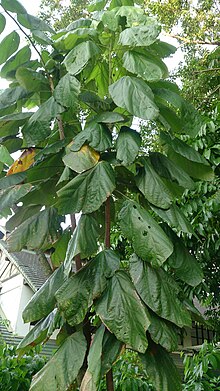Theobroma bicolor
| Theobroma bicolor | |
|---|---|

| |
| Scientific classification | |
| Kingdom: | Plantae |
| Clade: | Tracheophytes |
| Clade: | Angiosperms |
| Clade: | Eudicots |
| Clade: | Rosids |
| Order: | Malvales |
| Family: | Malvaceae |
| Genus: | Theobroma |
| Species: | T. bicolor
|
| Binomial name | |
| Theobroma bicolor | |
| Synonyms | |
|
Theobroma ovatifolia Moc & Sessé ex DC. | |
Theobroma bicolor, known commonly as the mocambo tree, jaguar tree, balamte,[2] or pataxte, among various other common names, is a tree in the genus Theobroma (family Malvaceae), which also contains the better-known Theobroma cacao (cocoa tree). It is found in Central and South America, including stretches of the Amazon rainforest in Brazil, Colombia, Ecuador, and Peru.
Taxonomy
Theobroma bicolor is the only species in the Rhytidocarpus section of Theobroma.[3] It was described by Alexander von Humboldt and Aimé Bonpland in 1808.[4]
Description
Theobroma bicolor can reach a height of 3–8 metres in open fields, although in the
Similar to its close relative, the cacao tree, the mocambo tree's seeds are edible, high in calories, and rich in protein and fiber. The seeds are also high in
Cultivation and use

Theobroma bicolor was historically cultivated by the
When the fruit is ripe, it naturally detaches from the tree branches and falls to the ground; the general method of harvesting is collecting the fallen fruit.[3]
Mayas placed a high value on the buttery foam crowning beverages of cacao and maize, according to descriptions from the time of the
Pests
Moniliophthora perniciosa, a fungus which causes "witch's broom disease" on T. cacao, was reported on a Brazilian specimen of T. bicolor in 1999.[8]
References
- . Retrieved 18 November 2021.
- ^ The Jaguar Tree (Theobroma bicolor Bonpl.) by Johanna Kufer and Cameron L. Mcneil. Published by the University Press of Florida.
- ^ ISBN 9789251023723
- ISBN 9783540410171
- ^ a b Theobroma bicolor (Macambo) at www.rainforestconservation.org.
- ^ Pataxte and cacao in Mayan ethnobotany, iconography, and art history by Nicholas M. Hellmuth, at www.maya-archaeology.org.
- ^ Judith Strupp Green. 2010. Feasting with Foam: Ceremonial Drinks of Cacao, Maize, and Pataxte Cacao. Pre-Columbian Foodways 2010, pp 315–343.
- ISSN 0103-3816


